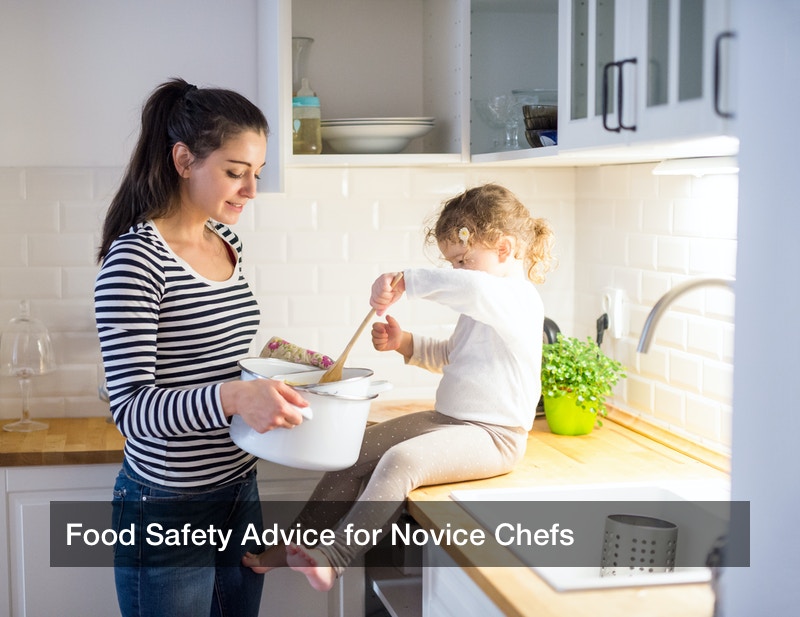
Cooking has become more than just a way to fuel our bodies: nowadays, cooking has become an art form. From crafting the most surprising flavor options to creating the most beautiful food displays, we have countless cooking shows paying homage to our love of food.
Food is tied to a person’s culture, their lifestyle, and the way that we show appreciation for others. We wouldn’t be human if we didn’t celebrate food in all its glory. It isn’t surprising to learn that Americans spend about 12% of their salary on eating out each year. Check-in software is essential for medical facilities but it’s becoming even more popular among some of the most popular restaurants in your local area. It’s rare to see even mom and pop restaurants without a quality POS system in place.
If you’re an amateur cook, there’s no better time than quarantine to start sharpening your knives and cleaning your mixers. With all this free time on our hands, many people have started baking their own breads, experimenting with their first soups, and burning more than a few homemade burritos in the process. Luckily, cooking shows and online tutorials have made it easier than ever to learn how to cook from the comfort of your own home. Unfortunately, these shows don’t often delve into the necessary safety measures newfound cooks should be performing. Food safety advice, however, is vital in the kitchen.
Even though cooking is necessary for our health, it comes with a few hazards that cannot be ignored. That’s why all restaurants are required to post food safety advice and information in accordance with OSHA guidelines. Any injuries on the job might fall on the employer’s head and they don’t want to have to shell out for an accident attorney and pay workers compensation.
It just goes to show that amateur home cooks should also be following this discretion in the kitchen. We know not to chop our fingers off, but do we know how to prevent this from happening in the first place? It’s not uncommon for burgeoning cooks to have to go to an urgent care center in their first few weeks of cooking (especially if they’re using a sharp mandolin).

If you’re one of the many rising cooks in the United States, here are some of the best pieces of food safety advice that you should be following:
Prep your cooking space
Accidents are wont to happen if you don’t prepare for them. Before you start cooking, it’s vital that you prepare your space. This doesn’t mean that you need to invest in a kitchen remodel with the help of local plumbers; rather, it means you simply need to clean surfaces, organize necessary ingredients, and get out the cutlery you need for a job well done.
This will help stop you from making accidents in the kitchen. When you know where everything is, you won’t have to rush to find that missing ingredient. Read your recipe thoroughly before cooking and organize your goods into sections. This will not only make cooking a new dish easier, but it will also help when it comes to cleaning up later.
Home chefs shouldn’t even turn on the stove until all of their ingredients are organized and prepped. Rinse your fruits and veggies, clean the fat off of your meats, and dice the items that need to be pre-cut. Future you will thank you later.
Watch your fingers
We use our hands for just about everything in life: bathing, snapping to a catchy beat, and, of course, cooking. If you don’t want to lose your favorite digits, you better start practicing food safety in the kitchen.
This means that you should rely on thermometers instead of your sense of touch. Burns are among the top accidents that occur in the kitchen, but you won’t be able to contact a personal injury attorney if you burn yourself on your own property. Whenever you take something out of the oven, it’s essential to wear gloves. Before you remove your meal from the oven, you should also clear a spot to put the pan/dish/etc. to avoid juggling too many tasks at once. Placing a hot dish on a kitchen counter is a bad idea unless it’s made out of pure stone. If you have regular laminate countertops, you’ll want to lay down a towel or a cooling rack before opening the oven.

Another common accident in the kitchen centers around knives and other sharp objects. We’ve been eating with these objects for years which can give us a false sense of security when we start cooking for the first time. Unfortunately, this can lead to serious cuts that need prompt medical attention. The best pediatrician can handle stitches, but you’ll have to go to the emergency room if you slice off your finger.
Here are some helpful chopping tips to avoid chopping off your fingers:
- Never put your index finger on the knife to steady it. This is a common misconception: most people think that setting your index finger on the top of the blade will keep the knife from moving. Unfortunately, this just makes it easier to slip from your grip. Grasp the blade’s handle with all of your fingers and chop food into smaller pieces so you don’t need that apparent extra force.
- Curl your fingers around what you’re cutting. If you’re holding an onion with one hand and chopping with another, you’ll want to curl in your fingers on the holding hand. This can prevent accidental slips from catching your finger. As long as you apply pressure to the food you’re chopping, it won’t slip — and even if it does, you can rest easy knowing that your fingers are safe.
- Sharpen your blades often. Accidents are more apt to happen when you’re working with a dull blade. Luckily, knife sharpeners are relatively affordable and can last for years to come. This is an investment that can save you a lot in terms of medical bills.
Speaking of hands and fingers, you should always wash your hands before cooking to prevent the spread of bacteria. Even though the fire typically does a good job of killing any germs, you never know when dirty hands can pose a health issue. Wash your hands before cooking and whenever they are soiled. You’ll rest easy as you pass through your luxury sliding glass doors onto the patio knowing that your food is safe to eat (even if it doesn’t taste that great the first time).
Watch the stovetop
Do you turn the handles of your pots and pans to the side when you cook? If you don’t, this is an accident waiting to happen.
Your stovetop is the cook’s best friend and worst enemy. From splatters to burns to fires, anything can go wrong if you’re not paying attention. For example, you should always turn your pot and pan handles to the side when you’re cooking: if you don’t, a stray elbow or errant sleeve might catch the handle and send the piping hot dish tumbling down. Don’t burn your legs: keep your handles pushed to the side.
You should also be wary of grease fires. This is more than just food safety advice: this is good life advice, too. A grease fire occurs when the food and oil on your pan get too hot and burst into flame. Our kneejerk reaction is to toss cold water on the pan, but this will actually spread out the grease and make the fire even larger. Your best bet is to cover it with a lid or a heat-resistant blanket. Be sure to have these items nearby whenever you’re cooking, but especially if you’re cooking with oil or frying up some yummy donuts.

This is especially important to teach teens who might want to try their hand at cooking for the first time. They might be more concerned about cleaning their Invisalign trays over cooking a meal and it’s up to you to teach them how to stay safe in the kitchen. Just like you learned to cook a step at a time, allow your teen to start with small tasks before moving up to bigger ones. Food safety advice is valuable for all ages.
Be wary of bones
Cooking with meats and fish that come with the bones can give you a flavor experience like no other. It’s fun to prepare a delectable meat and use all of the pieces. But even if you simply bought the wrong option at the store, you have to be careful when it comes to animals that are sold bone-in.
It’s sound food safety advice: chomping down on a bone can send you right to the oral surgeon if you’re not careful. Unfortunately, humans are not like dogs: we can’t chew and digest bones from animals. That’s why you should take the prepping process nice and slow. Start on smaller animals before you work your way up to big cuts. This will help you get used to the action of separating meat from bone. Otherwise, a careless mistake could result in a nasty disaster.
Luckily, online tutorials can help with this. After all, not every animal will be cut and prepared the same way. A fish is different from a chicken and so on. Rely on the multitude of resources before you to prepare a safe dish for you and your family.
Don’t test dishes on your dog
Dogs love human food. They love the taste, the smell, and the fact that they shouldn’t have it, those little rebels. Unfortunately, a lot of the food that we eat is incredibly harmful to dogs. Chocolate is the most well-known, but there are plenty of unassuming vegetables and fruits that your dog should never eat.

For example, your cats shouldn’t actually have milk and no pet should have caffeine. These foods are indigestible and can cause major issues in the gastrointestinal tract of your pet. Other foods are simply toxic because they cannot be absorbed by your pet’s body. If you toss your dog a grape, you might have to look up your nearest animal hospital to get them well again. After all, food safety advice is important for dogs, too, even if they don’t know the difference between good food and bad food.
Here are some of the most common foods that you should never feed your pets:
- Raisins and grapes
- Avocado and guacamole
- Corn on the cob
- Garlic
- Any alcohol
- Coffee/items with caffeine
Follow this food safety advice
There will always be a new piece of food safety advice to consider when you start cooking. However, these simple tips are a great way to get started. Unless you want to visit a dentist or take a trip to an urgent care clinic, these safety tips are a sure-fire way to keep your diners safe from harm — and your chef in-tact.
Related Keywords: banana 18 word cookies, answers to word cookies cinnamon 13, arrow word cookies, banana 12 word cookies, banana 13 word cookie answers, banana 14 word cookies answers, banana 16 word cookies answers, cinnamon 5 word cookies, jessica cakes blog, milk 8 word cookies, novice baker, vanilla 16 word cookies, vanilla special level word cookies, word cookies banana 11 special level, word cookies milk 13, word cookies special level banana, word cookies vanilla 10, chef club uk meatball pie, milk 3 word cookies, vanilla 10 word cookies, vanilla 10 word cookies answers.


